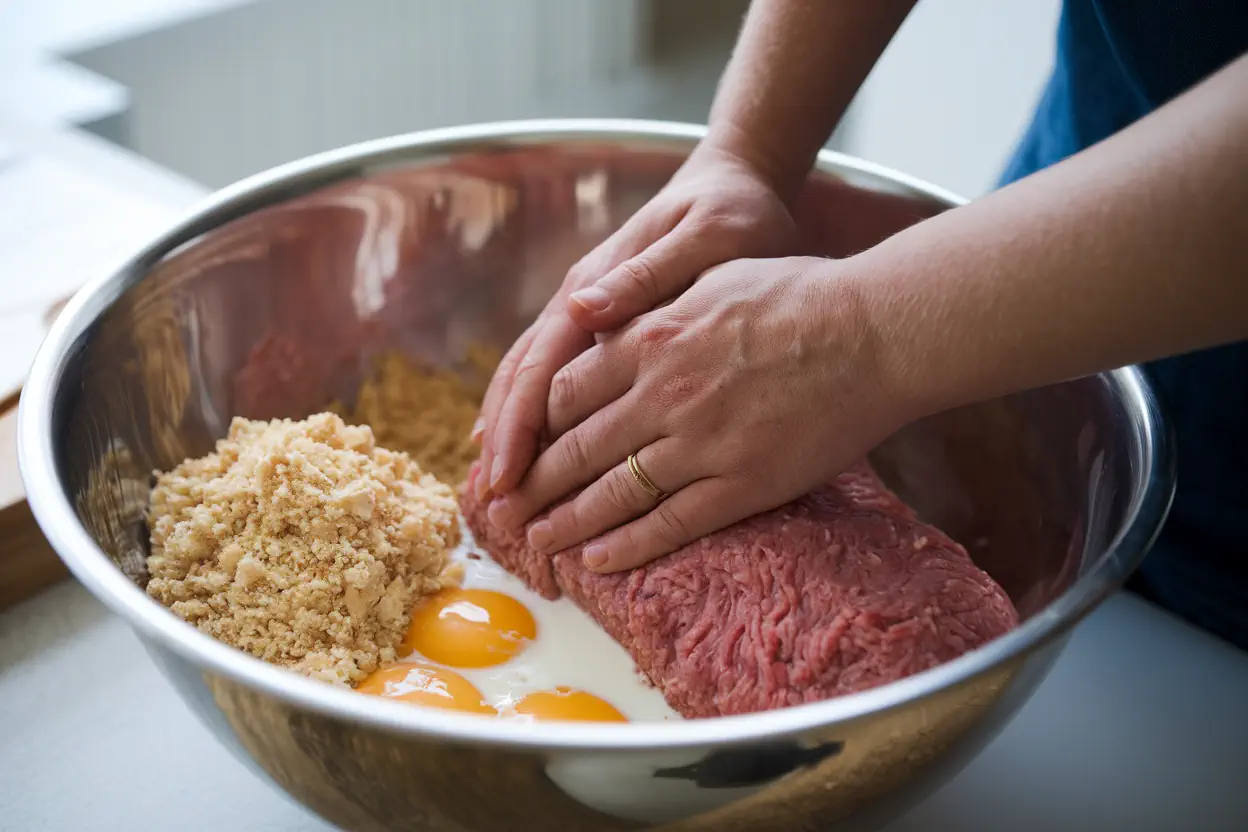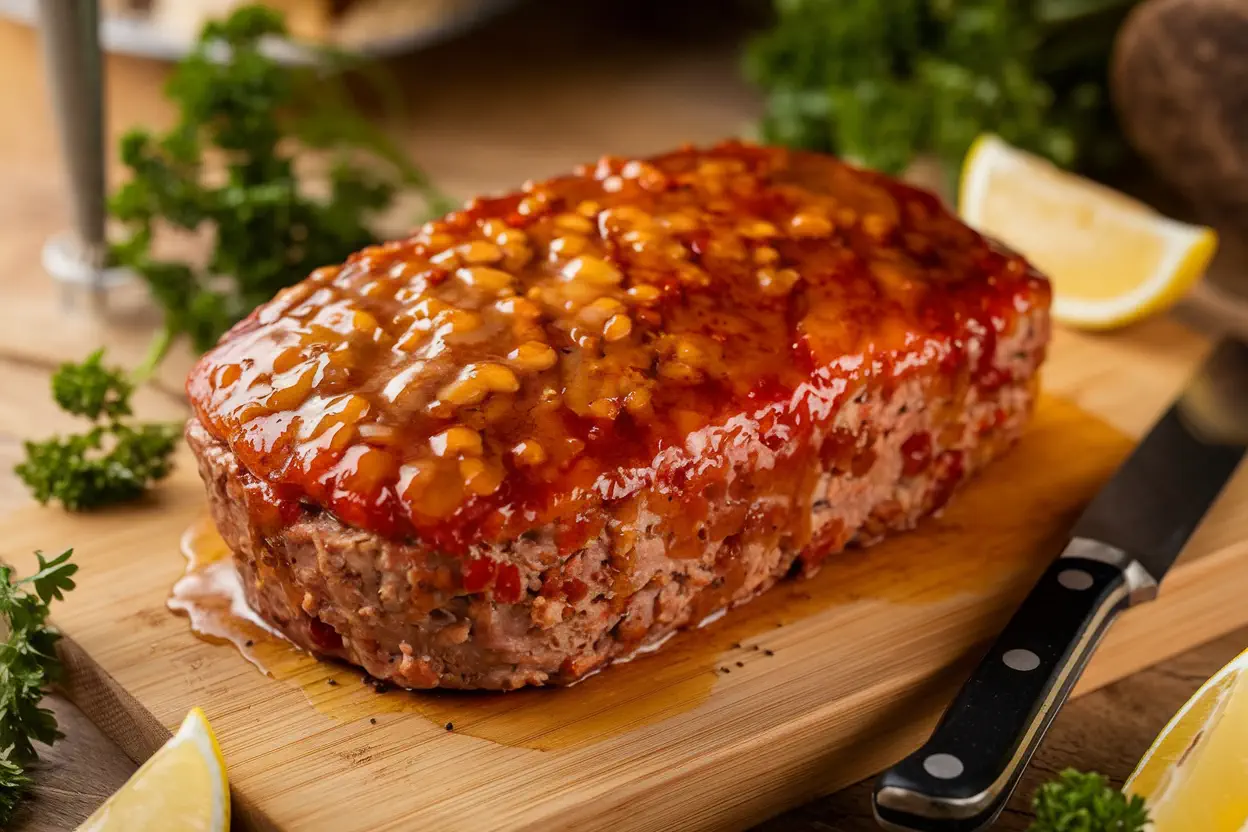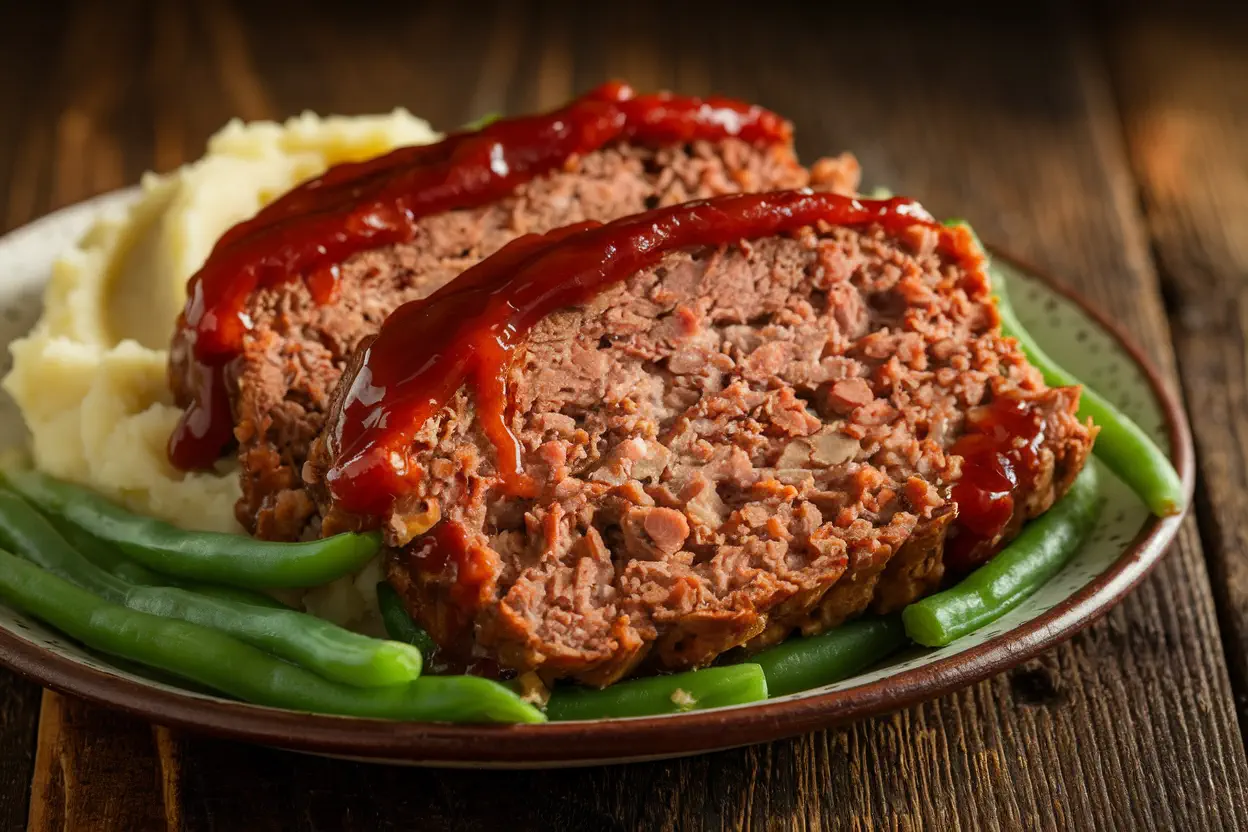Meatloaf has been a comfort food favorite for generations. But many home cooks often wonder, what is the secret to juicy meatloaf? This guide reveals the essential tips and tricks to help you create the perfect, moist, and flavorful loaf.
Table of Contents
The Basics of Meatloaf
What is Meatloaf?
Meatloaf is a versatile dish made from ground meat mixed with a variety of binders and seasonings, shaped into a loaf, and baked to perfection. It traces its roots back to ancient Rome but gained popularity in the U.S. during the Great Depression as an economical way to stretch proteins. Traditional meatloaf is often made with ground beef, breadcrumbs, eggs, and seasonings, but modern variations include everything from turkey to plant-based options.
Why is Juiciness Important? Discover What is the Secret to Juicy Meatloaf
A dry meatloaf is nobody’s idea of comfort food. Juiciness is the key to a delightful eating experience, ensuring each bite is tender, moist, and full of flavor. Without enough moisture, meatloaf can turn dense and rubbery, losing the rich texture that makes it a family favorite. Juiciness doesn’t just affect the texture—it also amplifies the taste, allowing seasonings and spices to shine.
Dry meatloaf often stems from a lack of balance in the ingredients. Too much lean meat, inadequate binders, or overcooking are common culprits. By understanding the basics, you’re already on your way to mastering a moist, flavorful loaf.
Choosing the Right Ingredients
Meat Selection Matters
When it comes to meatloaf, the type of meat you choose can make or break the dish. Fat content is essential to creating that signature juiciness. Lean meats like ground turkey or chicken can dry out quickly, so blending them with fattier cuts of beef or pork creates a perfect balance. Ground beef with a fat content of 80/20 is ideal, as it offers enough richness without becoming overly greasy. For a unique twist, consider mixing meats—beef, veal, and pork make a classic combination that delivers incredible flavor and texture.
The Importance of Binders
Binders are the unsung heroes of moist meatloaf. They hold everything together while adding much-needed moisture. Classic options like breadcrumbs, eggs, and milk create a cohesive texture and prevent the loaf from falling apart. If you’re seeking gluten-free alternatives, try oat flour, crushed rice crackers, or almond meal. Milk, in particular, is a key ingredient—it hydrates the breadcrumbs and ensures a tender bite. Curious why milk is so vital? It acts as a tenderizer, soaking into the meat mixture to prevent it from becoming tough.
Secret Add-Ins for Extra Juiciness
To elevate your meatloaf game, include moisture-rich add-ins. Finely grated vegetables like onions, carrots, or zucchini not only enhance the flavor but also release natural juices as they cook. Surprising additions like applesauce or sour cream can provide an extra layer of moisture and richness without overpowering the classic meatloaf taste. If you’re wondering what is the secret to juicy meatloaf, experimenting with these unexpected ingredients might just be the answer.
For a unique twist, consider trying the Lipton Onion Soup Meatloaf, which incorporates pre-made onion soup mix for added flavor.
Preparation Techniques

Mixing Matters
How you mix your meatloaf ingredients is as crucial as what you put in. Overmixing can lead to a dense, rubbery loaf, so handle the mixture with care. Combine your dry and wet ingredients separately before mixing them into the meat, and use your hands to gently incorporate everything. This approach ensures the flavors are evenly distributed without compacting the meat.
The Right Pan for the Job
The type of pan you use significantly impacts the final result. While loaf pans are popular, they can trap grease at the bottom, making the meatloaf soggy. Opt for a freeform loaf on a baking sheet or a broiler pan to allow excess fat to drain away. For those who love a crisp crust, the extra airflow from a freeform method is a game-changer.
Shaping Your Meatloaf for Success
Shaping your meatloaf properly is another step toward juiciness. Aim for a uniform thickness to ensure even cooking, and avoid pressing it too tightly—it needs space to breathe! A slight dome shape on top prevents pooling and promotes a moist interior. Using these preparation techniques, you’ll be one step closer to mastering what is the secret to juicy meatloaf.
Cooking Secrets
Temperature and Timing Are Key
Cooking your meatloaf at the right temperature is critical to keeping it juicy. Baking it too hot can cause the outside to dry out while leaving the center undercooked. The ideal temperature for baking meatloaf is 350°F (175°C). At this temperature, the loaf cooks evenly, locking in moisture while achieving that perfect golden crust. For the best results, use a meat thermometer to check the internal temperature—it should reach 160°F (71°C) for beef or 165°F (74°C) for poultry.
Timing is another important factor. A standard 2-pound meatloaf will take about an hour, but this can vary depending on the size and shape of your loaf. Always allow the thermometer to guide you rather than relying solely on the clock. After all, precision is the secret to juicy meatloaf.
To Cover or Not to Cover?
This age-old question has sparked debate among meatloaf enthusiasts. Covering your meatloaf with foil during the first half of baking can help retain moisture and prevent the top from drying out. Removing the foil in the final 15 minutes allows the glaze to caramelize beautifully. If you’re craving a crispier exterior, bake it uncovered the entire time, but be prepared to baste it with its own juices or extra glaze to keep it moist.
Using a Water Bath for Moisture
For an extra insurance policy against dryness, consider baking your meatloaf in a water bath. Simply place your loaf pan or baking tray in a larger dish filled with about an inch of hot water. This creates a steamy environment, ensuring that your meatloaf stays tender and juicy throughout. If you’ve been wondering what is the secret to juicy meatloaf, this little-known technique could be a game-changer.
Topping and Finishing Touches
The Role of a Flavorful Glaze
No meatloaf is complete without a delicious glaze to tie it all together. The classic ketchup glaze is a crowd-pleaser, blending tangy, sweet, and savory flavors. But why not elevate your topping game? Try adding a splash of Worcestershire sauce, brown sugar, or even a hint of sriracha for a kick of heat. Apply the glaze during the final 15-20 minutes of baking to avoid burning and ensure a glossy, flavorful finish.
For those who prefer a less traditional approach, experiment with barbecue sauce, honey mustard, or a balsamic reduction. These options bring a unique twist while still complementing the hearty flavors of the meatloaf.
Resting Your Meatloaf
Once your meatloaf is out of the oven, resist the urge to slice it immediately. Resting your meatloaf for 10-15 minutes allows the juices to redistribute evenly, ensuring that every slice is moist and flavorful. Cutting too soon can cause the juices to escape, leaving your meatloaf disappointingly dry.

Troubleshooting Common Problems
Why Does My Meatloaf Turn Out Dry?
A dry meatloaf is one of the most common complaints among home cooks. The primary culprits are overcooking, using lean meats, or skimping on binders and moisture-rich ingredients. To avoid this, always use a meat thermometer and stick to the recommended internal temperature. Incorporating ingredients like milk-soaked breadcrumbs or finely grated vegetables can also work wonders to lock in moisture. And remember, resting your meatloaf after baking ensures the juices don’t escape when slicing.
If you’ve ever asked yourself, what is the secret to juicy meatloaf?, the answer often lies in striking the perfect balance between fat, binders, and cook time. Don’t be afraid to tweak your recipe until you find your sweet spot!
Avoiding a Greasy Meatloaf
While fat is essential for flavor and juiciness, too much can leave your meatloaf greasy. To mitigate this, opt for a blend of ground meats with moderate fat content, such as 80/20 ground beef or a mix of lean turkey with fattier pork. Baking your meatloaf on a wire rack or broiler pan allows excess grease to drain away, preventing a soggy bottom. For a final touch, pat the surface with a paper towel after baking to remove any lingering oil.
Conclusion and Final Tips
Summing Up the Secrets
Mastering what is the secret to juicy meatloaf comes down to a few key principles: choosing the right ingredients, handling them with care, and cooking them just right. By following these tips—selecting a proper fat ratio, incorporating moisture-rich binders, and baking at the ideal temperature—you can ensure every slice is tender, juicy, and bursting with flavor.
Encouragement to Experiment
Don’t be afraid to put your own spin on the classic meatloaf recipe. Try new ingredients, experiment with glazes, or adjust the cooking method to suit your preferences. Every family has its unique twist on this comfort food favorite, and yours can too! With a bit of practice and creativity, you’ll soon discover the ultimate secret to the best meatloaf you’ve ever tasted.
Looking for a perfect side dish? Pair your meatloaf with a comforting Broccoli Cauliflower Soup for a hearty meal.
FAQs About Juicy Meatloaf
Why is milk important in what is the secret to juicy meatloaf?
Milk plays a vital role in what is the secret to juicy meatloaf by hydrating breadcrumbs to keep the loaf tender. This simple step prevents the loaf from drying out during baking. The milk-soaked breadcrumbs not only hold the meat together but also add a tender, moist texture to every bite. If you’re lactose-intolerant, substitutes like almond milk, chicken broth, or even water can achieve similar results.
What Helps Keep Meatloaf Moist?
The secret to moist meatloaf lies in combining the right ingredients and techniques. Using fatty meats, adding vegetables like onions or carrots, and incorporating wet ingredients like eggs or ketchup contribute to moisture. Cooking at a moderate temperature and allowing the loaf to rest after baking are equally important. These steps work together to create the perfect answer to the question: What is the secret to juicy meatloaf?
What Is the Secret to the Best Meatloaf?
While the term “best” is subjective, the real secret lies in balancing flavor and texture. A blend of meats, properly seasoned and bound with milk-soaked breadcrumbs, forms the foundation. Adding a glaze during the final minutes of baking enhances both taste and appearance. Finally, patience—allowing the meatloaf to rest—is the crowning touch.
Should You Cook Meatloaf Covered or Uncovered?
Both methods have their merits. Covering the meatloaf with foil at the start traps steam, ensuring a moist loaf. Uncovering it toward the end allows the glaze to caramelize and creates a satisfying crust. For the best of both worlds, combine the two methods for optimal results.
Creative Variations of Meatloaf
International Twists on a Classic Dish
If you’re looking to break away from tradition, try adding global flavors to your meatloaf. Incorporate Italian ingredients like Parmesan cheese, fresh basil, and marinara sauce for a Mediterranean vibe. For an Asian-inspired version, mix in ginger, soy sauce, and scallions, and finish with a teriyaki glaze. These variations infuse exciting new flavors while staying true to the concept of a juicy, hearty loaf.
Plant-Based and Health-Conscious Options
Even vegetarians can enjoy a satisfying “meatloaf.” Use lentils, chickpeas, or black beans as the base, and add mushrooms for a meaty texture. Gluten-free versions can swap breadcrumbs for almond flour or crushed oats. To retain moisture in these alternatives, be generous with vegetables and flavorful seasonings. If you’ve wondered, what is the secret to juicy meatloaf without meat, the answer lies in creativity and balance.
Personalized Meatloaf Creations
Why not turn your meatloaf into a canvas for your family’s favorite flavors? Add cheeses, bacon, or sun-dried tomatoes to the mix. For a fun twist, try stuffing the meatloaf with hard-boiled eggs or a layer of spinach and mozzarella. The possibilities are endless, and experimenting is a surefire way to keep the dish exciting and personalized.
If you’re exploring healthier options, you might love this guide on Cauliflower Pizza Crust Kirkland as a guilt-free treat.

